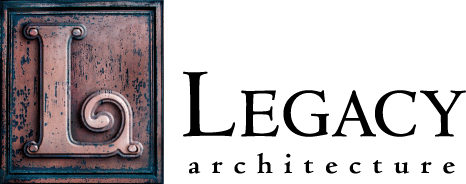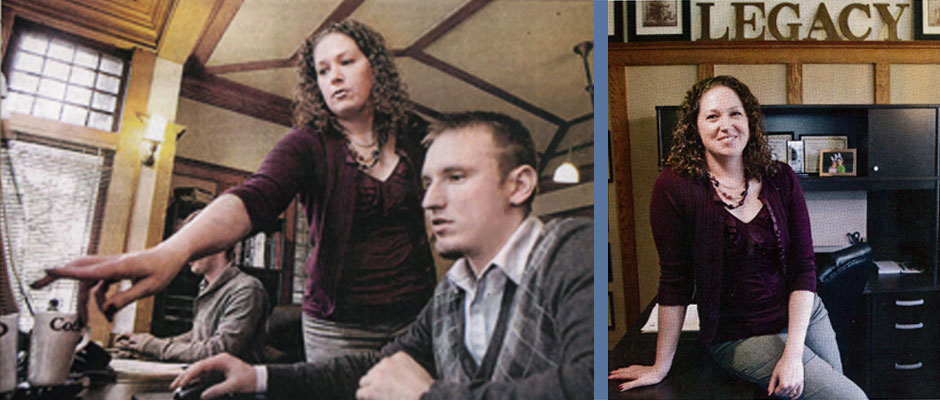Preserving History
Schultz, Deanne. The Sheboygan Press. November 18, 2012.
There are times when you look back on life and see defining moments that grabbed your hand and led you to today; in retrospect, they "click" and make sense.
Jennifer Lehrke probably wasn't feeling the love all those years ago as she stood in the sunshine of a summer day, helping her father tear siding off the family's old farmhouse on yet another remodeling project.
"At the time, I was thinking, 'Really? We're going to take all the siding off the house?'" she recalled with a laugh. "'I'm 10, I want to be with my friends.'"
Now, as owner of Legacy Architecture in Sheboygan, Lehrke, principal architect and preservation consultant, realizes that those years of remodeling experience provided the nuts and bolts essential to her current success.
"From an early age, I had a fascination with old buildings," she said.
That fascination continues undiminished today, as Lehrke and her staff delve into architecture in a way that most others don't - she's an historic preservation consultant, one of just a handful in Wisconsin who specialize in preserving and restoring early buildings.
It's work that takes Lehrke all along Wisconsin's eastern lakeshore, from communities like Burlington and Watertown in the south, to Allouez and Kaukauna farther north.
Many owners of businesses and homes of historical significance simply ask Lehrke to help undo what she calls previous "remuddling" projects - a 70s-style bathroom grates in the presence of anelegant turn-of-the-century living room, or a multitude of sins lurking behind a band-aid of paneling and shag carpeting need modernization.
"We're really good at respecting history, but finding ways to get modern amenities into houses," she said.
But the projects that really have her uncovering the mysteries of history involve buildings and homes destined for the prestigious National Register of Historic Places, "the official list of the nation's historic places worthy of preservation," according to the National Park Service's website.
Lehrke said buildings are eligible for the Register based on placement in one or more of four categories: architecture, history, event, or archaeology.
"The majority of the buildings listen on the National Register are there because of their architecture," Lehrke said.
A perfect example of this is Charlie Ratigan and Jennifer Hogan's 162-year-old cream city brick home in Manitowoc. After a 13-year meticulous renovation, the couple was ready to add their home to the National Register of Historic Places, calling upon Lehrke to prepare the nomination papers.
Their Italianate-style home was built in 1850 for Charles and Herriette Klingholz, and Lehrke said it meets the National Register's requirement in two categories - architecture and history.
"It really hadn't been touched much," she said. "(Ratigan and Hogan) maintained what was already there, and brought it back to its former glory."
The couple also updated judiciously - instead of installing modern-style windows, they respected the original mullioned style , having custom windows created for the space. They also eschewed a modern-style "dream kitchen," choosing instead a room that reflects life in the mid-1800s - no refrigerator, no range.
"They did a fantastic job," Lehrke said. "The National Register is all about 'Do you feel like you walked back in time?' and here you really do feel that."
The documentation necessary for adding a home or building to the National Register is very involved and Lehrke said the state recommends that individuals not tackle this alone.
"It has to be researched thoroughly," she said. "It really is an academic document, footnoted with a full bibliography. There are specifications on how it's written, how the photography is done."
She hauled a thick, comb-bound book off the shelf, the kind that looks like it would land with a thud on the floor, displacing swirls of dust. It's an example of an earlier project that resulted in the building's placement on the Register, with Lehrke noting that the document itself "ends up in Washington, D.C. at the National Park Service."
Homes or buildings listed on the National Register are also eligible for tax credits, and owners need to be aware of standards before proceeding.
"The government says 'We'll give you 25 percent state and federal tax credits, but you have to do it to standards,'" Lehrke said, noting that for some, like Ratigan and Hogan, historical connection and preservation were greater motivators than any tax advantages.
She also said that several misconceptions linger about additional "responsibilities" once a home or building is listed on the National Register, saying "People think they can't do anything to the building once it's listed, or they think they have to open it up for public tours," both of which are false.
According to the Wisconsin Historical Society's website, there are no restrictions on private property once listed on the State Register and the National Register. Owners are "encouraged to preserve" these properties, but there are no requirements in place to enforce this.
There are also three levels of National Register eligibility - local, state and national - based on the building's significance within each category.
For Lehrke, though, the intrigue of being a history detective is what feeds her, as she said, "knowing there's another historical building that will be preserved for future generations."
She estimates that one-third of her business is historical preservation, with the balance being architecture-driven, but even that amount often revolves around historical or existing buildings.
"I'm drawn to that; I go back to the things that happened in my childhood that you can connect," she said. "There's a few things in my life I can point to that set me up to where I am now."

